check engine BUICK PARK AVENUE 1994 Owners Manual
[x] Cancel search | Manufacturer: BUICK, Model Year: 1994, Model line: PARK AVENUE, Model: BUICK PARK AVENUE 1994Pages: 324, PDF Size: 17.01 MB
Page 80 of 324
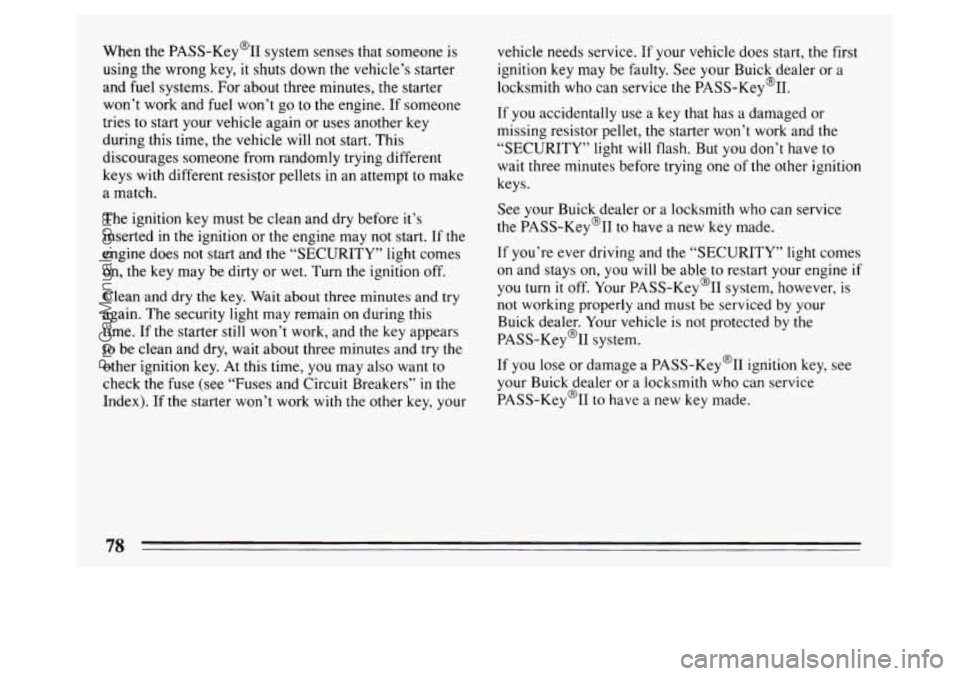
When the PASS-Key% system senses that someone is using the wrong key,
it shuts down the vehicle’s starter
and fuel systems. For about three minutes,
the starter
won’t work and
fuel won’t go to the engine. If someone
tries to start your vehicle again or uses another key
during this time, the vehicle will not start. This
discourages someone from randomly trying different
keys with different resistor pellets in an attempt to make
a match.
The ignition key must be clean and dry before it’s
inserted in the ignition or the engine may not start. If the
engine does not start and the “SECURITY’’ light comes
on, the key may be dirty
or wet. Turn the ignition off.
Clean and dry the key. Wait about three minutes and try
again. The security light may remain on during this
time. If
the starter still won’t work, and the key appears
to be clean and dry, wait about three minutes and try the
other ignition key. At this time, you may also want to
check the fuse (see “Fuses and Circuit Breakers”
in the
Index). If
the starter won’t work with the other key, your vehicle needs
service. If your vehicle does start, the first
ignition key may be faulty. See your Buick dealer or a
locksmith who can service the PASS-Key@II.
If you accidentally use a key that has a damaged or
missing resistor pellet, the starter won’t work and the
“SECURITY” light
will flash. But you don’t have to
wait three minutes before trying one of the other ignition
keys.
See your Buick dealer or
a locksmith who can service
the PASS-Key@II to have a new key made.
If you’re ever driving and the “SECURITY” light comes
on and stays on,
you will be able to restart your engine if
you turn it off. Your PASS-Key% system, however, is
not working properly
and must be serviced by your
Buick dealer. Your vehicle is not protected by the
PASS-Key% system.
If you lose or damage a PASS-Key@II ignition key, see
your Buick dealer or a locksmith who can service
PASS-Key@II to have a
new key made.
78
ProCarManuals.com
Page 84 of 324
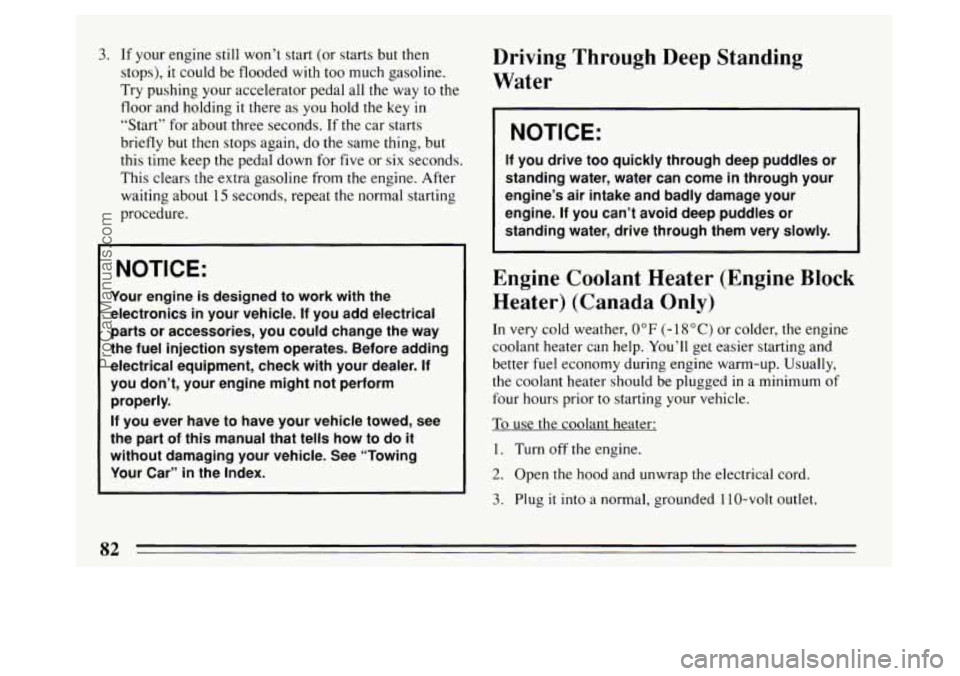
3. If your engine still won’t start (or starts but then
stops),
it could be flooded with too much gasoline.
Try pushing your accelerator pedal all the way to the
floor and holding
it there as you hold the key in
“Start” for about three seconds. If the car starts
briefly but then stops again, do the same thing, but
this time keep the pedal down for five or
six seconds.
This clears the extra gasoline from the engine. After
waiting about
15 seconds, repeat the normal starting
procedure.
NOTICE:
Your engine is designed to work with the
electronics in your vehicle.
If you add electrical
parts or accessories, you could change the way
the fuel injection system operates. Before adding
electrical equipment, check with your dealer.
If
you don’t, your engine might not perform
properly.
If you ever have to have your vehicle towed, see
the part of this manual that tells how to
do it
without damaging your vehicle. See “Towing
Your Car”
in the Index.
Driving Through Deep Standing
Water
I NOTICE:
If you drive too quickly through deep puddles or
standing water, water can come
in through your
engine’s air intake and badly damage your
engine.
If you can’t avoid deep puddles or
standing water, drive through them very slowly.
Engine Coolant Heater (Engine Block
Heater) (Canada Only)
In very cold weather, 0°F (- 18 “C) or colder, the engine
coolant heater can help. You’ll get easier starting and
better fuel economy during engine warm-up. Usually,
the coolant heater should be plugged
in a minimum of
four hours prior to starting your vehicle.
To use the coolant heater:
1. Turn off the engine.
2. Open the hood and unwrap the electrical cord.
3. Plug it into a normal, grounded 1 10-volt outlet.
82
ProCarManuals.com
Page 127 of 324
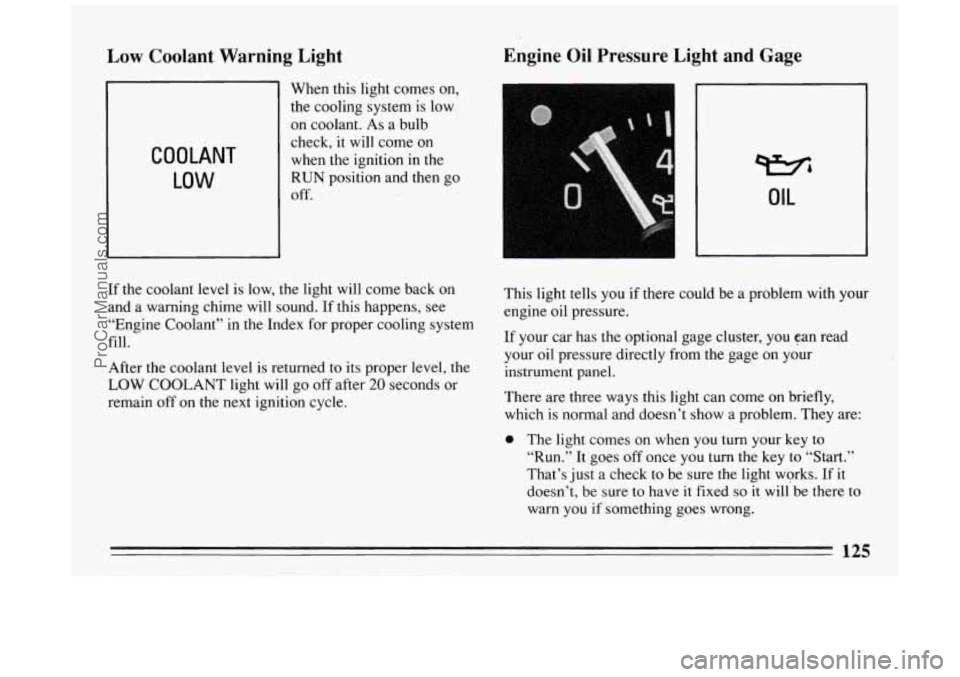
Low Coolant Warning Light Engine
Oil Pressure Light and Gage
COOLANT
LOW
When this light comes on,
the cooling system is low
on coolant. As a bulb
check, it will come on
when the ignition in the
RUN position and then go
Off.
Wb
OIL
If the coolant level is low, the light will come back on
and
a warning chime will sound. If this happens, see
“Engine Coolant’’ in the Index for proper cooling system
fill.
After the coolant level is returned to its proper level, the
LOW COOLANT light will go off after 20 seconds or
remain off
on the next ignition cycle. This
light
tells you if there could be a problem with your
engine oil pressure.
If your car has the optional gage cluster, you can read
your oil pressure directly from the gage on your
instrument panel.
There are three ways this light can come on briefly,
which
is normal and doesn’t show a problem. They are:
0 The light comes on when you turn your key to
“Run.”
It goes off once you turn the key to “Start.”
That’s just a check
to be sure the light works. If it
doesn’t, be sure
to have it fixed so it willbe there to
warn you if something goes wrong.
125
ProCarManuals.com
Page 128 of 324
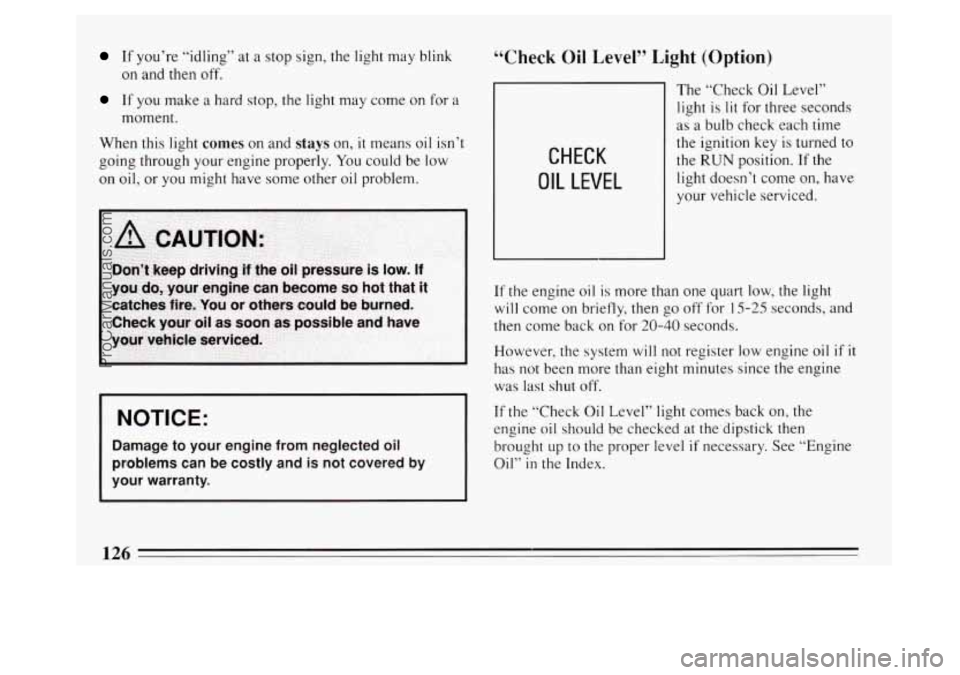
If you’re “idling” at a stop sign, the light may blink
on and then off.
If you make a hard stop, the light may come on for a
moment.
When this light
comes on and stays on, it means oil isn’t
going through your engine properly,
You could be low
on oil,
or you might have some other oil problem.
NOTICE:
Damage to your engine from neglected oil
problems can be costly and is not covered by
your warranty.
“Check Oil Level” Light (Option)
CHECK
OIL LEVEL
The “Check Oil Level”
light is
lit for three seconds
as
a bulb check each time
the ignition key
is turned to
the
RUN position. If the
light doesn’t come on, have
your vehicle serviced.
If the engine oil is more than one quart low, the light
will come on briefly, then go off for 15-25 seconds, and
then come back on for
20-40 seconds.
However, the system
will not register low engine oil if it
has not been more than eight minutes since the engine
was last shut off.
If the “Check Oil Level” light comes back on, the
engine oil should be checked at the.dipstick then
brought
up to the proper level if necessary. See “Engine
Oil”
in the Index.
ProCarManuals.com
Page 129 of 324
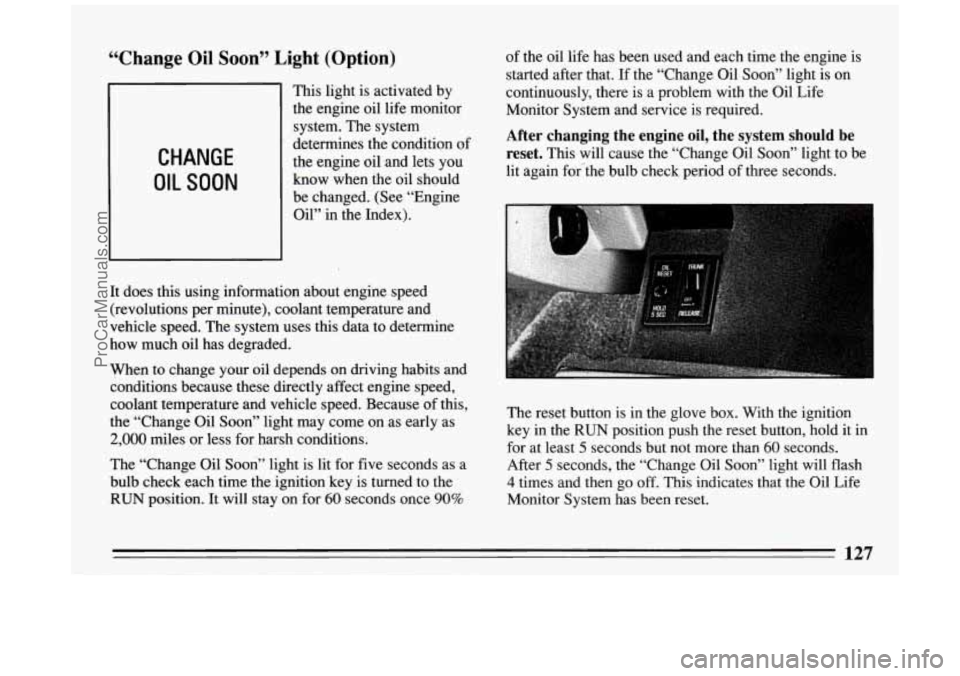
“Change Oil Soon” Light (Option)
CHANGE
OIL SOON
This light is activated by
the engine oil life monitor
system. The system
determines the condition
o
the engine oil and lets you
know when the oil should
be changed. (See “Engine
Oil” in the Index).
It does this using information about engine speed (revolutions per minute), coolant temperature and
vehicle speed. The system uses this data to determine
how much oil has degraded. of
the oil life has been used and each time the engine is
started after that.
If the “Change Oil Soon” light is on
continuously, there is a problem with the Oil Life
Monitor System and service is required.
After changing the engine oil, the system should be
reset.
This will cause the “Change Oil Soon” light to be
lit again for#the bulb check period
of three seconds.
When to change your oil depends on driving habits and
conditions because these directly affect engine speed,
coolant temperature and vehicle speed. Because of this,
the “Change Oil Soon” light may come on as early as
2,000 miles or less for harsh conditions.
The “Change Oil
Soon” light is lit for five seconds as a
bulb check each time the ignition key is turned to the
RUN position. It will stay on for 60 seconds once 90%
f
The reset button is in the glove box. With the ignition
key in the
RUN position push the reset button, hold it in
for at least
5 seconds but not more than 60 seconds.
After
5 seconds, the “Change Oil Soon” light will flash
4 times and then go off. This indicates that the Oil Life
Monitor System has been reset.
127
ProCarManuals.com
Page 130 of 324
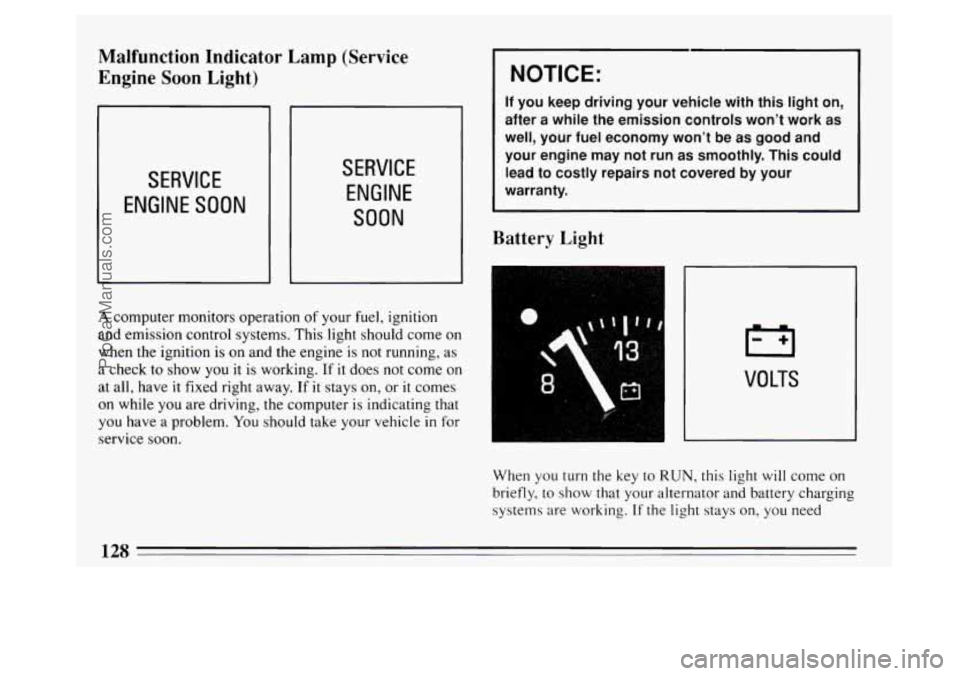
Malfunction Indicator Lamp (Service
Engine Soon Light)
SERVICE
ENGINE SOON
NOTICE:
If you keep driving your vehicle with this light on,
after a while the emission controls won’t work as
well, your fuel economy won’t be as good and your engine may not run
as smoothly. This could
lead to costly repairs not covered by your
warranty.
SERVICE
ENGINE
SOON
Battery Light
A computer monitors operation of your fuel, ignition
and emission control systems. This light should come on
when the ignition is on and the engine is not running, as
a check to show you it is working.
If it does not come on
at all, have it fixed right away. If it stays
on, or it comes
on while you are driving, the computer
is indicating that
you have
a problem. You should take your vehicle in for
service soon.
n
VOLTS
When you turn the key to RUN, this light will come on
briefly,
to show that your alternator and battery charging
systems are working. If the light stays on, you need
ProCarManuals.com
Page 131 of 324
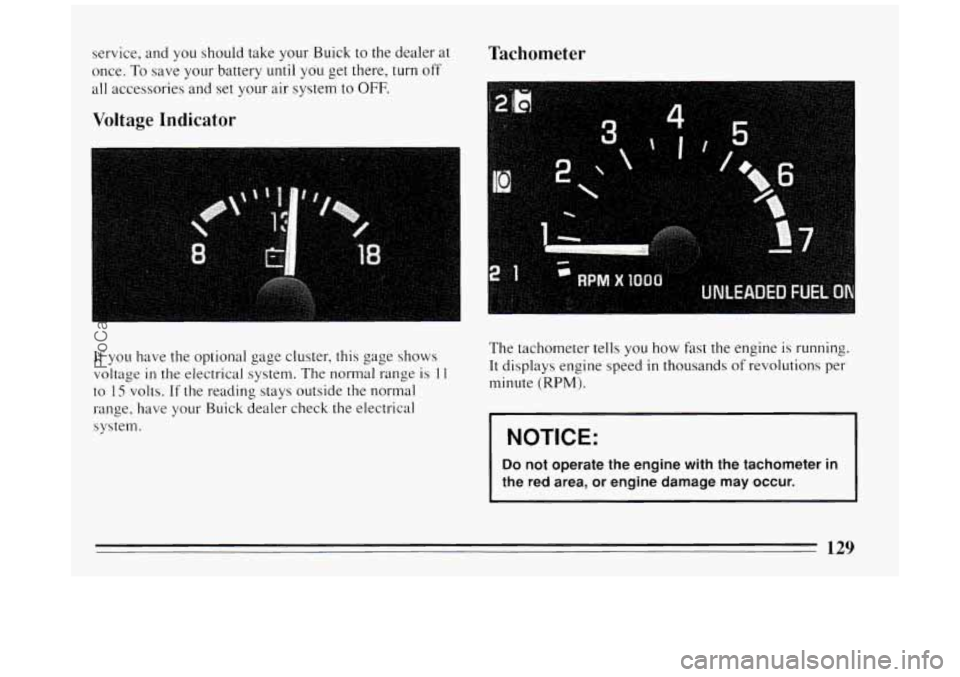
service, and you should take your Buick to the dealer at
once.
To save your battery until you get there, turn off
all accessories and set your air system to OFF.
Voltage Indicator Tachometer
If you
have the optional gage cluster, this gage shows
voltage in the electrical system. The normal range is 11
to 15 volts. If the reading stays outside the normal
range, have your Buick dealer check the electrical
system. The tachometer tells
you how fast the engine is running.
It displays engine speed
in thousands of revolutions per
minute
(RPM).
I NOTICE:
Do not operate the engine with the tachometer in
the red area,
or engine damage may occur.
129
ProCarManuals.com
Page 146 of 324
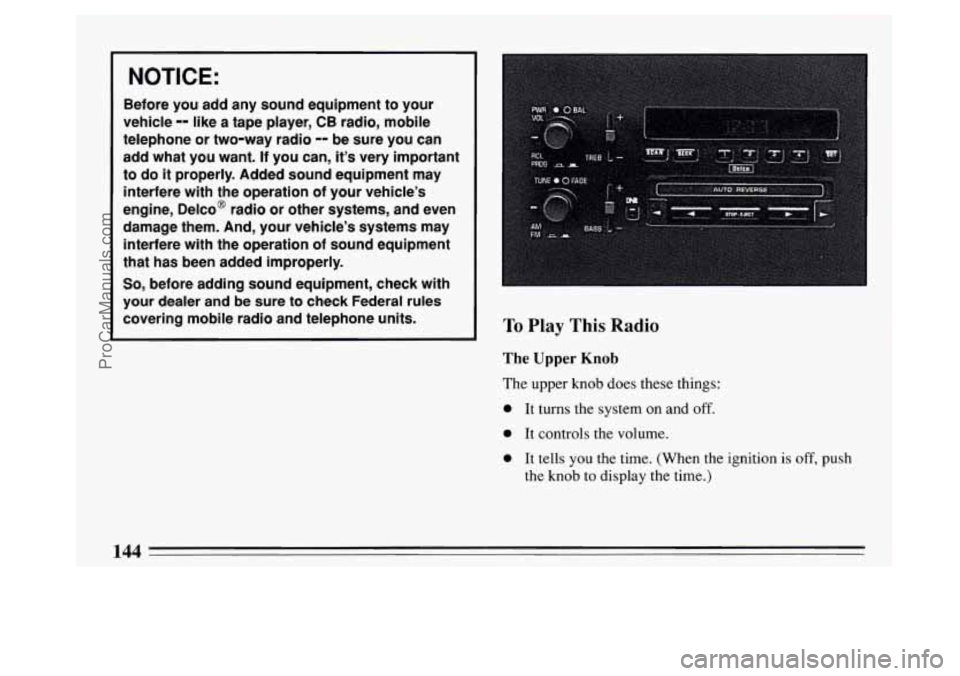
NOTICE:
Before you add any sound equipment to your
vehicle
-- like a tape player, CB radio, mobile
telephone or two-way radio
-- be sure you can
add what you want. If you can,
it’s very important
to
do it properly. Added sound equipment may
interfere with the operation of your vehicle’s
engine, Delco@ radio or other systems, and even
damage them. And, your vehicle’s systems may
interfere with the operation of sound equipment
that has been added improperly.
So, before adding sound equipment, check with
your dealer and be sure
to check Federal rules
covering mobile radio and telephone units.
144
.
ProCarManuals.com
Page 183 of 324
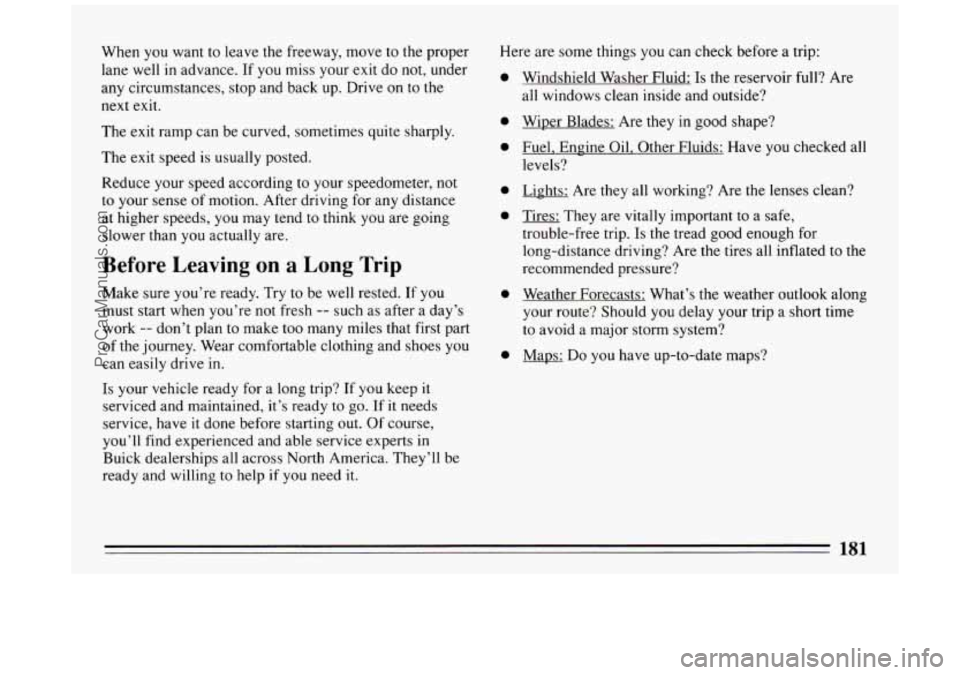
When you want to leave the freeway, move to the proper
lane well
in advance. If you miss your exit do not, under
any circumstances, stop and back up. Drive on to the
next
exit.
The exit ramp can be curved, sometimes quite sharply.
The exit speed
is usually posted.
Reduce your speed according to your speedometer, not
to your sense of motion. After driving for any distance
at higher speeds, you may tend to think you are going
slower than you actually are.
Before Leaving on a Long Trip
Make sure
you’re ready. Try to be well rested. If you
must start when you’re not fresh
-- such as after a day’s
work
-- don’t plan to make too many miles that first part
of the journey. Wear comfortable clothing and shoes you
can easily drive in.
Is your vehicle ready for a long trip? If you keep it
serviced and maintained, it’s ready to go. If it needs
service, have it done before starting out.
Of course,
you’ll find experienced and able service experts in
Buick dealerships all across North America. They’ll be
ready and willing to help
if you need it.
Here are some things you can check before a trip:
0
0
0
0
0
0
0
Windshield Washer Fluid: Is the reservoir full? Are
all windows clean inside and outside?
Wiper Blades: Are they
in good shape?
Fuel, Engine Oil, Other Fluids: Have you checked all
levels?
Lights: Are they all working? Are
the lenses clean?
Tires: They are vitally important
to a safe,
trouble-free trip.
Is the tread good enough for
long-distance driving? Are the tires all inflated to the
recommended pressure?
Weather Forecasts: What’s the weather outlook along
your route? Should
you delay your trip a short time
to avoid a major storm system?
Maps:
Do you have up-to-date maps?
181
ProCarManuals.com
Page 184 of 324
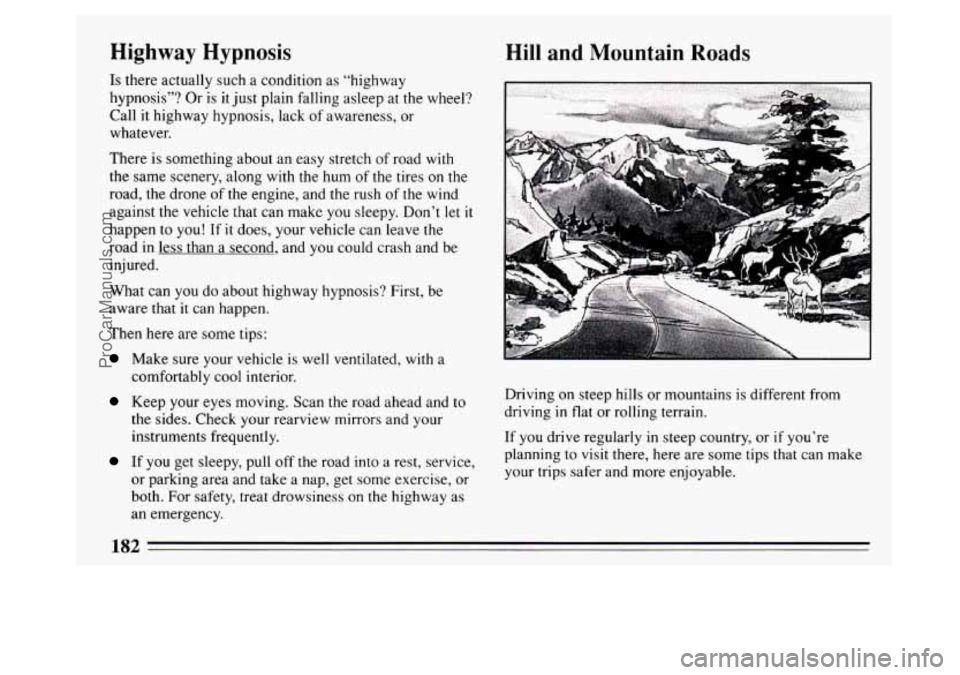
Highway Hypnosis
Is there actually such a condition as “highway
hypnosis”? Or is it just plain falling asleep at the wheel?
Call
it highway hypnosis, lack of awareness, or
whatever.
There is something about an easy stretch
of road with
the same scenery, along with
the hum of the tires on the
road, the drone of the engine, and the rush of the wind
against the vehicle that can make you sleepy. Don’t let
it
happen to you! If it does, your vehicle can leave the
road
in less than a second, and you could crash and be
inj ured.
What can you do about highway hypnosis? First, be
aware that it can happen.
Then here are some tips:
Make sure your vehicle is well ventilated, with a
comfortably cool interior.
Keep your eyes moving. Scan the road ahead and to
the sides. Check your rearview mirrors and your
instruments frequently.
If you get sleepy, pull off the road into a rest, service,
or parking area and take a nap, get some exercise, or
both. For safety, treat drowsiness on the highway as
an emergency.
Hill and Mountain Roads
Driving on steep hills or mountains is different from
driving in flat or rolling terrain.
If
you drive regularly in steep country, or if you’re
planning
to visit there, here are some tips that can make
your trips safer and more enjoyable.
182
ProCarManuals.com